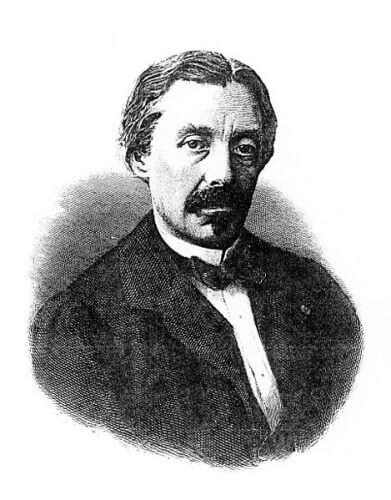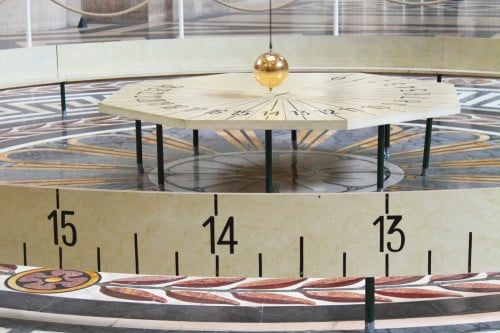The developments of one of the most versatile inventors of the 19th century still serve us today, but at the time he was rejected from any academic position except that of editor of a popular science journal, until Napoleon III came along and made him the Royal Astronomer

Jean Bernard Léon Foucault (1819-68 Jean Bernard Léon Foucault) was a French physicist who became particularly famous for his research on the speed of light when he determined its speed in air and discovered that the speed of light in water and other media decreases proportionally to the angle of refraction.
He designed Foucault's pendulum, with which he demonstrated the movement of the earth. He also improved the instruments. He studied the eddy currents named after him (Fouco currents) - an electric current that is excited in metals by the movement of the magnetic field. Together with Armand Piso he produced the first clear photograph of the sun. From 1855 until his death in 1868 he worked as a physicist at an observatory in Paris.
Leon Foucault was orphaned by his father, a publisher who published volumes on the history of France, at the age of nine, and returned with his mother from Nantes, where they moved for a short time, to Paris. Leon was also a sick child and was not accepted in society. Even in the prestigious high school where his mother sent him, he did not get good grades because he was late in submitting his papers, until his mother increased his studies by financing private lessons. However, he had other talents. As a boy he liked to build toys and machines, some of them sophisticated such as a steam engine or a telegraph. His mother decided that he would be an excellent surgeon and after completing his matriculation certificate, he began studying at the School of Medicine in Paris in 1839. At first he made good progress. His lecturer Alfred Donné (Donné) was pleased with him, however, he immediately fainted when he first entered a hospital and saw blood. After unsuccessfully trying to overcome this reluctance, he decided to give up the medical profession. Dunn wanted Foucault to continue contributing his skills to medical science, but without contact with patients and decided to hire him as his assistant."
As a hobby he also learned his photographic methods from Louis Jacques Manda Daguerre, one of the pioneers of photography. Together with his college friend Armand Piso he conducted experiments and improved the photographic process. Foucault combined his photography skills with his work as Dunn's assistant, and used them to develop microscopic photography abilities. For this purpose, he was required to invent a powerful electric light source to illuminate the photographed objects. . In 1845 he published a manual containing eighty pictures of objects under the microscope.
Dunn was the scientific editor of the Journal des Débats which was published daily. He resigned from the position in 1845 and passed the task to Foucault. His friend Bernard wrote that he carried out the task with impressive success. He considered making science accessible to the general public a mission, and dived into the science of his time, despite all the uncertainties and debates, and managed to convey the message to the public, even if he upset many scientists along the way.

When word of Foucault's research on microscopic photography became known, the astronomer Francois Jean-Dominique Arago decided to utilize Foucault's skills in the field of astronomy as well and asked Foucault and his colleague Piso to photograph the sun. It was the first photo of the sun and you can even see some sunspots in it. Arago continued and asked to employ Poco and Piso in measuring the speed of light in water, but then the two quarreled and each performed the experiment separately.
Foucault built a steam engine that operated a whirling mirror. In April 1850 he showed that light travels more slowly in water than in air. This matched the prediction of light theory, but conflicted with other theories. Foucault later wrote in his biography: "I did not invent the revolving mirror nor the chromatic lenses, nor the grid or the micrometer, but I had the good fortune to build the device proposed by other scientists in such a way that it helped me solve a problem that had been proposed about a decade earlier."
The next invention is still named after him - Foucault's pendulum. A pendulum swings freely in any direction without resistance. He estimated that the initial movement of the pendulum would preserve the plane of rotation in space, while the movement of the earth below it. In January 1851, he succeeded in building such a pendulum in the basement of his house and indeed demonstrated for the first time the movement of the earth. He told Argo about his achievement and Argo asked him to repeat the experiment at the Paris Observatory. On February 3, 1851, all the scientists in Paris were invited to watch Foucault's pendulum experiment in a public demonstration at the Mitzvah, and this time the experiment was also successful. Arago read to the members of the Academy an article written by Foucault about the pendulum in which the Sine Law was presented T = 24/sin q where T is the time required for the pendulum to return to its starting position and q is the latitude where the experiment was performed, so that at the poles it will take 24 hours for the return of the pendulum to its initial position while at the equator it will not rotate at all. Bina presented the full report to the Academy of Sciences giving the mathematical explanation for China's law on February 17.
Foucault's next invention was the gyroscope. He developed it to illustrate in a different way the movement of the earth. Again the gyroscope remains fixed in space while the Earth moves. It was an invention without practical significance in Foucault's time, but today it is used in a wide variety of applications - in airplanes, guidance of telescopes (including the Hubble Space Telescope) and even in advanced cell phones.
Since he did not have a scientific education, his only work was editing the magazine, but when Louis Napoleon came to power, who dissolved the National Assembly and who appointed himself Emperor of France Napoleon III, he decided to promote Foucault as part of his general support for science (he was an amateur scientist) and made him an astronomer The Imperial, that is, the director of the national observatory of France. Foucault built excellent telescopes for the observatory and added innovative features to them. He made many scientific discoveries and invented many machines that helped the astronomers at the observatory. In one of the experiments, he determined the speed of light with the best level of accuracy for his time, and it is also close to the real figure by half a percent.
In 1860 he traveled with a delegation to Spain to observe the solar eclipse of July 18. He was the first to photograph the eclipse and was awarded honorary degrees for it. Napoleon III awarded him the Order of the Legion in 1862. He was also a member of the Longitude Commission (1862) and was also elected a Fellow of the British Royal Society and a member of the Leopoldina German Academy of Sciences. In 1865 he was elected to the French Academy of Sciences.
In October 1867 he began to feel that his hands were falling asleep. It was the first sign of multiple sclerosis. The disease progressed rapidly and a few months later, on February 11, 1868, he died.
post Scriptum. The Foucault Pendulum hangs inside the observatory building in Givatayim, the center of the Israel Astronomical Society.

2 תגובות
exciting. Thanks.
I happened to see Foucault in a very surprising place - the great church of Bologna in Italy.